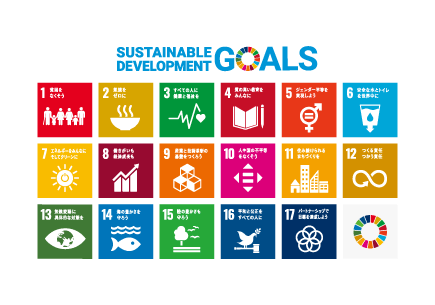- HOME
- Sustainability|Disclosure Based on the TCFD Recommendations
Disclosure Based on the TCFD Recommendations
We disclose material information about climate-related issues in compliance with recommendations of the Task Force on Climate-related Financial Disclosures (TCFD).
- Governance
- Strategy
- Risk Management
- Metrics and Targets
Governance
The Group has established the Sustainability Committee chaired by President and Representative Director to tackle significant business challenges such as respect for human rights, occupational health and safety, consideration for climate change and the environment, and anti-corruption, promoting management with a sustainability perspective to contribute to the realization of a sustainable society.
The committee analyzes scenarios, discusses measures to address risks or opportunities identified, sets targets, reviews our policies, and reassesses progress of the initiatives. Results of the discussions and reassessment are regularly reported to the Board of Directors by the committee through management meetings. The Board of Directors considers concrete measures to tackle climate change, strategies behind the measures and initiative policies on major issues before results of the deliberations are used to make decisions by operations managers in each department.
Sustainability Committee Structure


Strategy
The Group is providing foods stably and building and improving a sustainable supply chain to deliver safe and reliable food to customers as an integrated food company.
Climate change caused by global warming has a significant impact on the supply chain of the Group, whose businesses are based on food. In our steady and sustainable development, we consider reducing greenhouse gas emissions as one of the most important problems to control climate change. We conducted a scenario analysis to identify risks and opportunities arising from climate change.
Scenarios Used for the Analysis
To grasp impacts of climate change on our business environment as of 2030, we selected the 4℃ and 1.5℃ scenarios for the analysis, referring to an RCP scenario by the Intergovernmental Panel on Climate Change (IPCC) and scenarios by the International Energy Agency (IEA) to identify physical risks caused by climate change and transition risks resulting from the shift to a decarbonized society respectively (Table 1).
| 4℃ scenario | 1.5℃ scenario | |
|---|---|---|
| Summary | In this scenario, the global average temperature is supposed to rise by approximately 4℃ above pre-industrial levels (the late 19th century) in 2100 because of narrow-scope policies on climate change. Although we are affected by physical risks such as intensification of extreme weather, the impact of transition risks is small due to not tightened regulations related to climate change. | In this scenario, proactive decarbonization policies are supposed to limit a rise in the global average temperature to 1.5℃ above pre-industrial levels in 2100. Despite a relatively smaller impact of physical risks than the 4℃ scenario, we are affected by transition risks caused by policies and regulations related to climate change, such as a carbon tax. |
| Reference scenarios | Transition Risks: IEA Stated Policy Scenario (STEPS) | Transition Risks: IEA Net Zero Emissions by 2050 (NZE) and Sustainable Development Scenario (SDS) |
| Physical Risks: IPCC Representative Concentration Pathways (RCP) 8.5 | Physical Risks: IPCC RCP 2.6 |
Scenario Analysis Results
4℃ Scenario
The 4℃ scenario predicts physical impacts resulting from climate change such as more extreme weather. The impacts on the Group include business suspension caused by disaster and poor growth of crops due to climate change. We are dispersing our manufacturing bases both domestically and internationally to avoid risks of procurement difficulties caused by the above factors.
1.5℃ Scenario
The 1.5℃ scenario predicts that we are affected by transition impacts arising from the decarbonization of society through such measures as a carbon tax and policies regarding renewable energy and energy saving. The risk to the Group represents increase in operation costs due to use of renewable energy and introduction of carbon pricing (a carbon tax and the emissions trading scheme). To address the challenge, we consider to install energy-saving equipment and solar panels. On the other hand, the opportunities include reduction in the purchase amount of electricity due to an early introduction of energy-saving or renewable energy installations and improvement of external reputation by proceeding with efforts for environment. We continue the introduction of eco-friendly equipment and the eco renewable energy business to contribute to a decarbonized society while considering to enrich the information disclosed such as a GHG emissions reduction target.
| Climate-related risks and opportunities | Expected events | Materiality assessment | Our approaches | ||||
|---|---|---|---|---|---|---|---|
| 4℃ Scenario |
1.5℃ Scenario |
||||||
| Transition | Risks | Policies and regulations | Introduction of a carbon tax and emissions trading schemes |
|
Small | Large |
|
| Restrictions on greenhouse gas emissions and the use of fossil fuels |
|
Small | Medium | ||||
| Plastic regulations |
|
Small | Medium |
|
|||
| Food recycling regulations |
|
Small | Small |
|
|||
| Policies on renewable energy and energy saving |
|
Small | Large |
|
|||
| Technology | Advancement in low-carbon technology |
|
Small | Small | |||
| Market | Fluctuations in raw material costs |
|
Small | Medium | - | ||
| Shifts in customer preferences |
|
Small | Medium |
|
|||
| Opportunities | Policies and technology | Policies on renewable energy Spread of renewable energy technologies |
|
Small | Large | - | |
| Technology | Advancement in next-generation technology |
|
Small | Medium | - | ||
| Reputation | Reputation from customers and investors |
|
Small | Large |
|
||
| Physical | Risks | Acute | Intensifying extreme weather |
|
Large | Large |
|
| Chronic | Damage to crops from climate change |
|
Medium | Medium | |||
Risk Management
We have established the business crisis management guidelines and the risk management guidelines for the entire Group. In accordance with these guidelines, information about potential risks in the Group's businesses is collected and organized in the managers meeting, and then the risks are evaluated based on factors such as the degree of impacts on our business. To avoid or treat more significant risks, the managers meeting considers the policy and detail measures before instructing each department of the Group. Risks related to climate change are managed through the process to control risks across the Group with the Sustainability Committee and the managers meeting working together.
In our integrated risk management process, including climate-related risk management, the Internal Auditors audit a status of risk management, evaluate its effectiveness, and as necessary, report them to the Board of Directors and the Audit and Supervisory Committee.
Metrics and Targets
The Group has calculated greenhouse gas emissions (Scope 1 and 2) to assess and manage climate-related risks and opportunities.
To pass limited resources and the beautiful global environment to the next generation, we endeavor to lower impacts of our businesses on the environment by reducing waste and green gas emissions and using resources and energy more efficiently. The entire group is committed to addressing climate change and other environmental issues to achieve an environmentally friendly and sustainable society.





